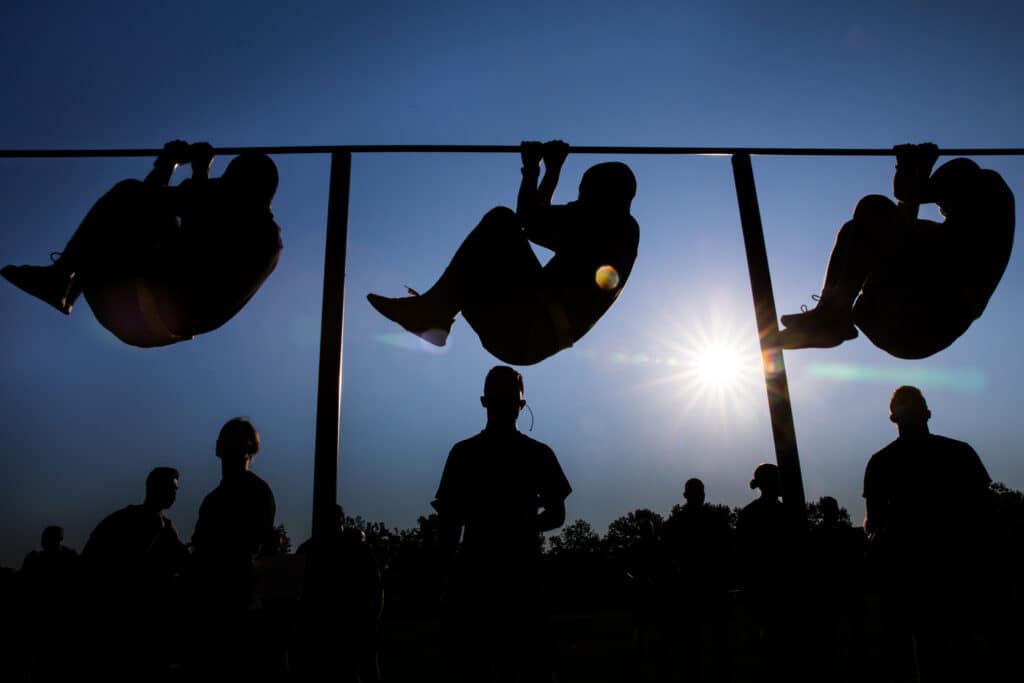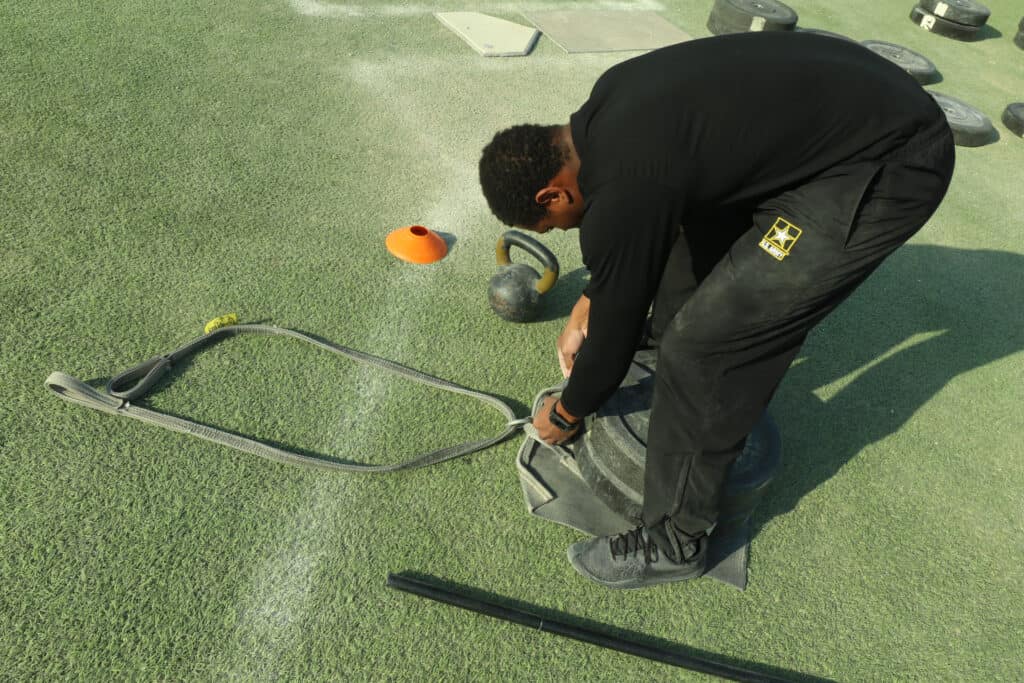Are you considering joining and serving in the army? Do you have what it takes to be a soldier? Are you preparing for the test but not sure what series of tests you will go through? This article will walk you through everything you need to know about the test to prepare if you are an aspiring soldier. Or maybe you are someone who is interested in CrossFit style workouts. This is also for you. But before that, this article will also tell you what kind of fitness test was used before and why it was changed.

ARMY PHYSICAL FITNESS TEST (APFT) – The Old School Way
The three-event APFT gave scores to soldiers on a sliding scale based on age and gender. This test started in the ’80s and lasted until early 2020. Older service members weren’t obligated to meet identical standards of younger troops, and women were given scores on separate criteria.
The APFT consists of push-ups, sit-ups, and a 2-mile run, all done in that order on the same day. Soldiers are allotted a minimum of 10 minutes and a maximum of 20 minutes rest between events and should be accomplished in two hours. The test period is described as the period of time that passes from the beginning to the end of the three events.
The series of events cannot be altered and there are no exemptions. The Officer in Charge (OIC) or the Non-Commissioned Officer in Charge (NCOIC) decides the recovery time and it is usually based on the number of Soldiers taking the test. If huge numbers of soldiers are being tested, staggered start times should be purposed to provide decent recovery between test events. Under no conditions is the APFT valid if soldiers cannot start and finish all three events in two hours or less.
WHAT IS THE ACFT?
ACFT stands for the Army Combat Fitness Test, which replaces the old Army fitness test used since 1980. The ACFT is an extremely upgraded version of the old physical fitness test soldiers must pass as part of their military service. It is age and gender-neutral, considered a “strenuous” test, and replaces the old three-event test with six events. ACFT standards are critical for the security of the Soldier and the readiness of the Army. Soldiers and Graders must understand the test standards and should know how to deliver them to be victorious on the ACFT.
Military operations become more difficult; that is why soldiers must be physically and mentally equipped for all challenges to succeed. The ACFT will help you attain full physical fitness and mental endurance under tension. The ACFT is designed with the most advanced exercise science and physical training judgment to empower soldiers to finish various combat tasks. The test comprises six fitness elements that enhance everything from muscular strength and power to flexibility and coordination.

WHY DO THEY HAVE TO CHANGE THE OLD TEST?
The previous test measures aerobic and muscular endurance, but it doesn’t coordinate with all of the complex fitness qualifications confronted during combat. The new test measures additional factors, including muscular strength, speed, agility, balance, flexibility, and coordination.
The APFT only has a forty percent predictive power for combat performance, but the new ACFT has an eighty percent predictive power. Thus, this test is a more reliable measurement of a soldier’s combat readiness.
WHAT ARE THE TEST EVENTS?
The test standard shows the criteria expected for each movement and the minimum score required for various classes of soldiers. A score of “70” is the minimum for soldiers in “heavy” physically demanding units or jobs; a score of “65” is for soldiers in “significant” physically demanding units or jobs, and a score of “60” is for soldiers in “moderate” physically demanding units or jobs. A “60” is the overall Army minimum standard for passing the ACFT.
Before doing each test, a warm-up is more than important to prepare your body and stimulate your cardiovascular system by boosting your body temperature and raising blood flow to your muscles.
1. Three Repetition Maximum Deadlift (MDL)
Deadlift the maximum weight possible three times.
The MDL event represents movements needed to safely and efficiently lift heavy loads from the ground, jump, bound, and allow landing. It demands well-conditioned back and leg muscles and helps soldiers avoid upper and lower back sprains due to moving long distances under heavy load.
Fitness Component: Muscular strength, flexibility, and balance
Standard Equipment: 60-pound hex bar and plates
Field Test: 60 and 100 point scores: 140 pounds and 340 pounds

2. Standing Power Throw (SPT)
Throw a 10-pound medicine ball backward and overhead for distance.
The SPT event signifies tasks demanding swift explosive movements to maneuver equipment and personnel.
Fitness Components: Explosive power, flexibility, and balance
Standard Equipment: 10-pound medicine ball
Field Test: 60 and 100 point scores: 4.5 and 12.5 meters
3. HAND RELEASE PUSH-UP – ARM EXTENSION (HRP)
Finish as many Hand-Release Push-ups as possible in two minutes.
The HRP is an upper-body strength test that represents repeated and sustained pushing used in combat tasks.
Fitness Components: Muscular endurance
Standard Equipment: Kettlebells
Field Test: 60 and 100 point scores: 10 and 60 repetitions
4. SPRINT-DRAG-CARRY (SDC)
Conduct 5 x 50-meter shuttles for time – sprint, drag, lateral, carry, and sprint.
The SDC is a test of power, endurance, and anaerobic capacity, which are needed to achieve high-intensity action tasks that last from a few seconds to several minutes.
Fitness Components: Agility, muscular strength, anaerobic endurance, and muscular endurance
Standard Equipment: 2×40-pound kettlebells and 90-pound sled
Field Test: 60 and 100 point scores: 3:00 and 1:33 minutes

5. LEG TUCK (LTK)
Complete as many leg tucks as possible; keep a relative vertical posture while moving the hips and knees up and down without unnecessary swinging.
The LTK evaluates the power of the soldier’s grip, shoulder, arm, and trunk muscles. These muscles help soldiers in load carriage and abstaining injuries to the back.
Fitness Components: Muscular strength and endurance
Standard Equipment: Climbing Bar
Field Test: 60 and 100 point scores: One and 20 reps
6. TWO-MILE RUN (2MR)
Run two miles for time on a measured, commonly flat outdoor course.
Your aerobic endurance will be measured which is needed for conducting continuous operations and ground movements on foot. Higher aerobic endurance enables the body to recuperate swiftly in preparation for performing other physically difficult duties that may appear during a ground movement, such as acting swiftly to enemy contact.
Fitness Components: Aerobic endurance
Standard Equipment: Two-mile run route on a track, level field, or running exterior
Field Test: 60 and 100 point scores: 21:00 and 13:30 minutes
ACFT EQUIPMENT
-
-
-
- ACFT equipment standards are identical across the Army. Here is the list of equipment that you will be using:
- Hex Bar – it is needed for each lane.
- Bumper Plates – 550lbs of single hi-temp bumper plates are expected for each lane.
- Hex Bar Collar – Two hex bar collars are required per lane. They are created to be used on 50mm hex bar sleeves to protect and have a snug fit against the bumper plates.
-
-

-
-
-
- Sled with Pull Strap – One sled that can handle up to four 45lb bumper plates and pull strap are required per lane.
- 10LB Solid Medicine Ball – One 10lb medicine ball (approximately 9 inches in diameter) is needed per lane.
- 40LB Kettlebell – Two 40lb kettlebells made with a slip-free texture with a seamless and even finish are required per lane.
-
-

-
-
-
- Measuring Tape – One measuring tape is expected per lane. The tape should be a strong, long-lasting vinyl-coated fiberglass tape in a shatter-resistant case that has an easy-to-wind, flush-folding handle.
- Climbing Bars – Required for physical readiness training and testing and should be arranged in groups of four.
-
-

-
-
- Portable Pull-up Bar – Authorized as a substitute to the Climbing Bar for the Leg Tuck event.
- Bike – A stationary bicycle that tests a soldier’s lower body muscular stamina.
- Rower – A stationary rowing ergometer that examines a Soldier’s upper and lower body muscular resistance.
-
COOL DOWN
After all the test events, don’t forget to cool down, as this will enable your body to transition to a relaxing or near-resting state progressively. It also helps regulate blood flow, especially if you did endurance training.
CONCLUSION
Now that you know the test events of ACFT, do not forget to begin by training the individual events. Then practice doing them in a series, one after the other. Also, begin with a more moderate resistance or less weight and slowly build as you become stronger. Now you are ready for the Army Combat Fitness Test. Good luck!

REFERENCES:
https://militarybenefits.info/army-combat-fitness-test-2/
https://www.goarmy.com/soldier-life/becoming-a-soldier/army-combat-fitness-test.html
https://www.military.com/military-fitness/army-fitness/army-combat-fitness-test-acft-score-chart
https://www.up.edu/armyrotc/files/reading-material/fm-7-22-appendix-a-apft.pdf
https://www.performancehealth.com/articles/exercises-to-get-ready-for-the-armys-apft-or-acft
https://www.army.mil/acft/
https://www.army.mil/e2/downloads/rv7/acft/acft_ioc.pdf
Photo Credits
Some photos on this page were provided by the U.S. DoD.
The appearance of U.S. Department of Defense (DoD) visual information does not imply or constitute DoD endorsement.